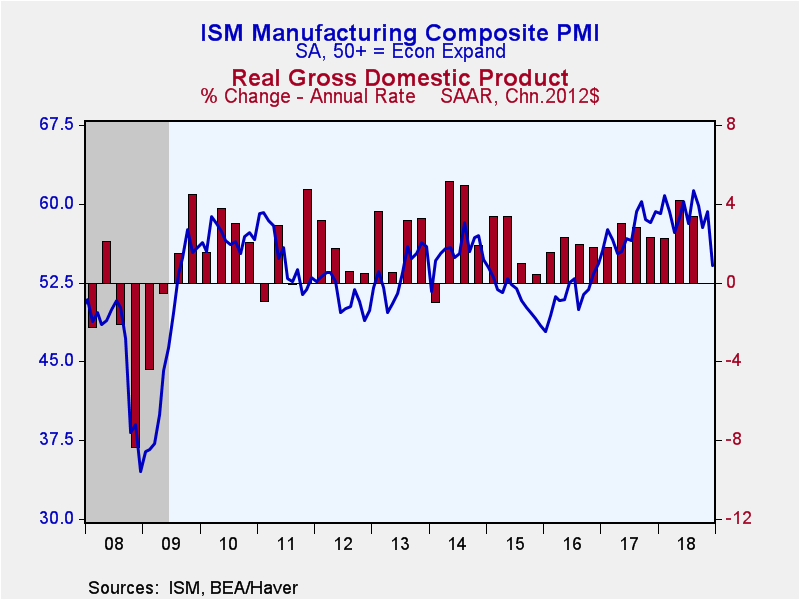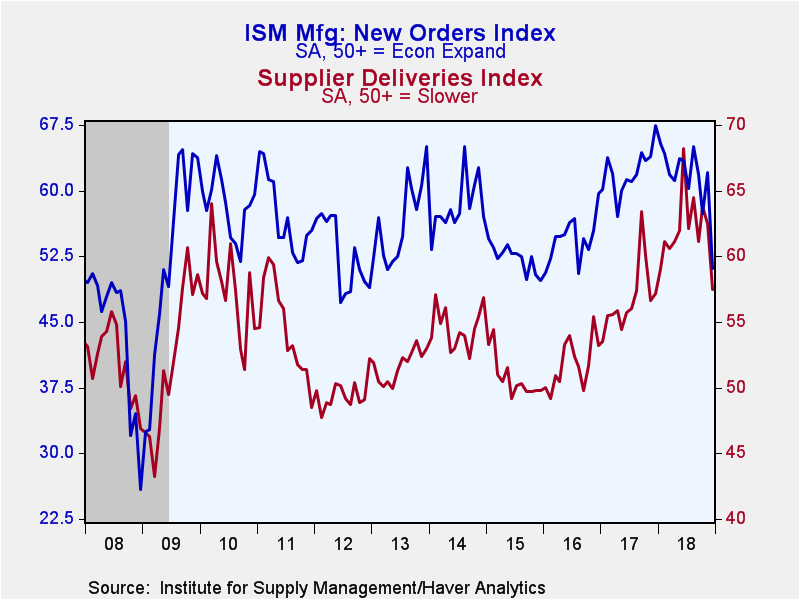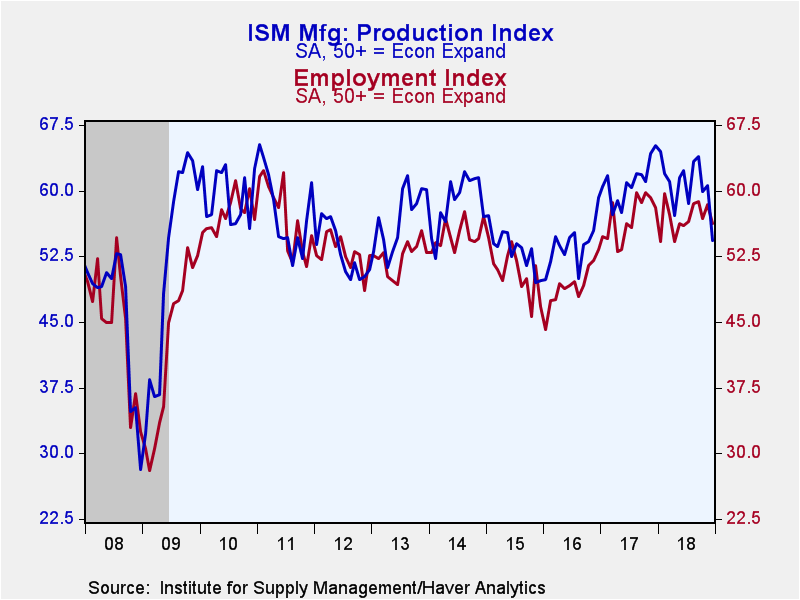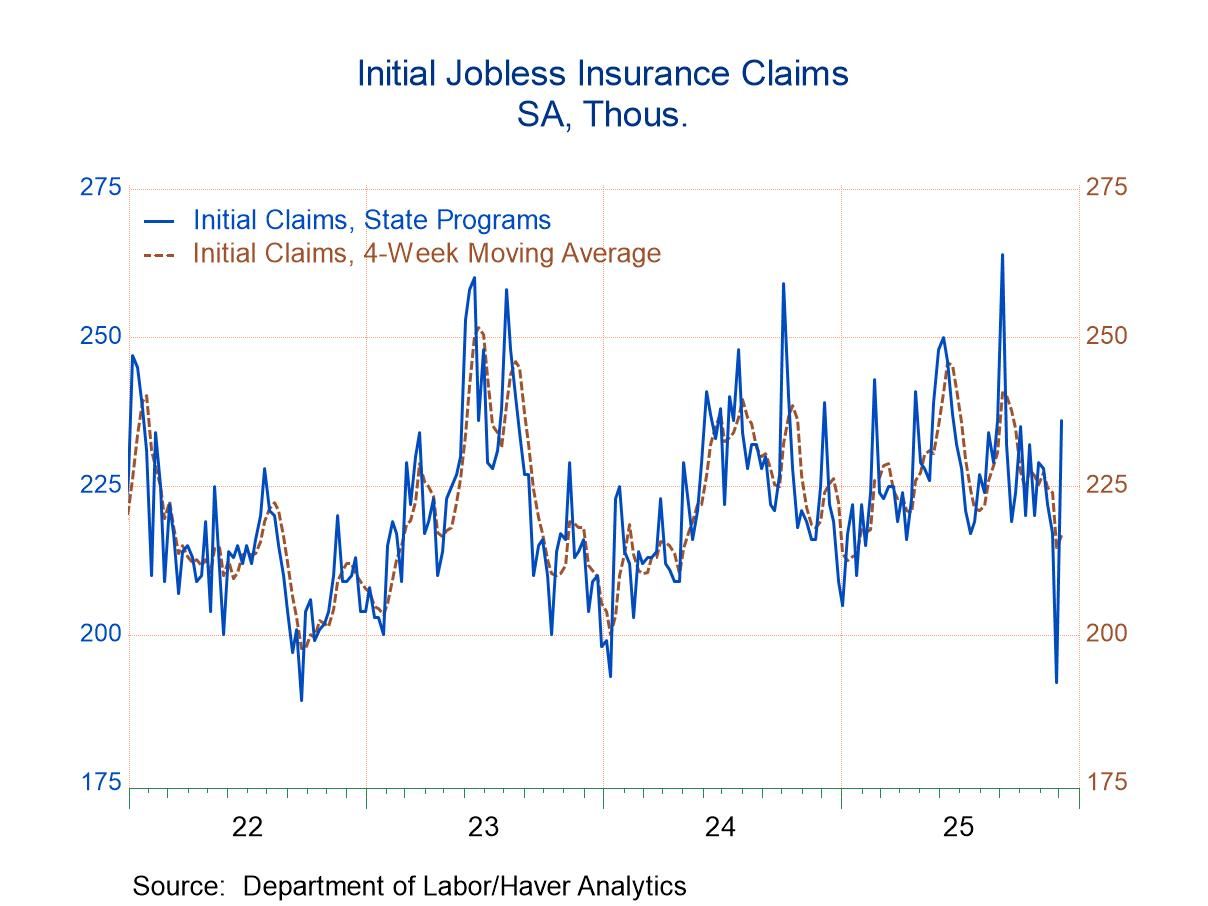 Global| Jan 03 2019
Global| Jan 03 2019ISM Factory Sector Index Weakens
by:Tom Moeller
|in:Economy in Brief
Summary
The ISM composite index of business activity in the factory sector fell to 54.1 during December after rising to 59.3 in November. It was the lowest reading since November 2016. A level of 57.8 had been expected in the Action Economics [...]
The ISM composite index of business activity in the factory sector fell to 54.1 during December after rising to 59.3 in November. It was the lowest reading since November 2016. A level of 57.8 had been expected in the Action Economics Forecast Survey. During all of 2018, the index averaged 58.8, the highest level since 2004. In the last ten years, there has been a 62% correlation between the index level and q/q growth in real GDP.
The decline in the overall index was broad-based amongst the component series. The new orders index fell to 51.1. It was the lowest level since August 2016 and down from the December 2017 peak of 67.4. The production component also approximated the 2016 low with a decline to 54.3. The index peaked at 65.2 in December 2017. The supplier delivery index fell sharply to 57.5 and indicated the quickest rate of order fulfillment in twelve months. The inventories index eased to 51.2 and showed a lessened rate of accumulation.
The employment index declined to 56.2, its lowest level in six months. A greatly reduced 19% of respondents reported an increased level of hiring while a fairly steady 11% reported a decline. During the last ten years, there has been an 82% correlation between the index level and the m/m change in factory sector payrolls.
The prices paid index declined to 54.9. That was down from the May high of 79.5 and stood at its lowest level since June 2017. Twenty-seven percent of respondents reported higher prices, roughly half the percentage this past spring. A greatly increased 17% reported paying lower prices.
In the separate indexes of factory sector activity, the export order index was fairly steady m/m at 52.8. That was down, however, from the February high of 62.8. The imports index weakened to the lowest level in just over a year. The order backlog measure declined from its May high to the lowest point in roughly two years.
The ISM figures are diffusion indexes where a reading above 50 indicates expansion. The figures from the Institute for Supply Management can be found in Haver's USECON database; further detail is found in the SURVEYS database. The expectations number is available in Haver's AS1REPNA database.
| ISM Mfg (SA) | Dec | Nov | Oct | Dec'17 | 2018 | 2017 | 2016 |
|---|---|---|---|---|---|---|---|
| Headline Index | 54.1 | 59.3 | 57.7 | 59.3 | 58.8 | 57.4 | 51.4 |
| New Orders | 51.1 | 62.1 | 57.4 | 67.4 | 61.5 | 62.2 | 54.5 |
| Production | 54.3 | 60.6 | 59.9 | 65.2 | 60.8 | 61.0 | 53.8 |
| Employment | 56.2 | 58.4 | 56.8 | 58.1 | 56.9 | 56.8 | 49.2 |
| Supplier Deliveries | 57.5 | 62.5 | 63.8 | 57.2 | 62.0 | 56.8 | 51.8 |
| Inventories | 51.2 | 52.9 | 50.7 | 48.5 | 52.9 | 50.4 | 47.5 |
| Prices Paid Index (NSA) | 54.9 | 60.7 | 71.6 | 68.3 | 71.7 | 65.0 | 53.1 |
Tom Moeller
AuthorMore in Author Profile »Prior to joining Haver Analytics in 2000, Mr. Moeller worked as the Economist at Chancellor Capital Management from 1985 to 1999. There, he developed comprehensive economic forecasts and interpreted economic data for equity and fixed income portfolio managers. Also at Chancellor, Mr. Moeller worked as an equity analyst and was responsible for researching and rating companies in the economically sensitive automobile and housing industries for investment in Chancellor’s equity portfolio. Prior to joining Chancellor, Mr. Moeller was an Economist at Citibank from 1979 to 1984. He also analyzed pricing behavior in the metals industry for the Council on Wage and Price Stability in Washington, D.C. In 1999, Mr. Moeller received the award for most accurate forecast from the Forecasters' Club of New York. From 1990 to 1992 he was President of the New York Association for Business Economists. Mr. Moeller earned an M.B.A. in Finance from Fordham University, where he graduated in 1987. He holds a Bachelor of Arts in Economics from George Washington University.










